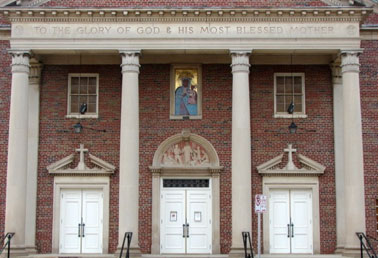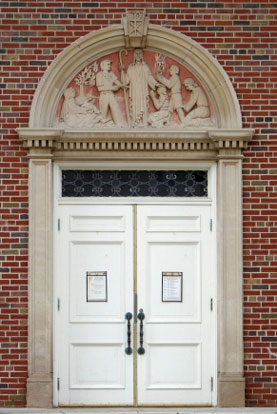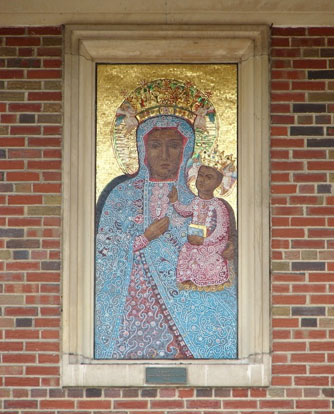13. St. Mary of Czestochowa Catholic, 1954
Now Our Lady of Divine Providence Catholic
3055 North Fratney Street (at Burleigh Street)
Architect: Myles Belongia
Milwaukee’s Polish immigrant and Polish-American population grew rapidly in the late nineteenth and early twentieth centuries, from about 30,000 in 1890 to 100,000 by 1915. The Catholic Church responded by establishing new Polish-language parishes at an increasing distance from the original centers of Polish settlement on the South Side and the Lower East Side. St. Mary of Czestochowa forms the third in a line of Polish Catholic churches that begins with St. Hedwig’s at Humboldt and Brady Streets, established in 1871. St. Hedwig’s was followed by St. Casimir, established in 1893 and located about one mile north of St. Hedwig’s in the Riverwest neighborhood. Finally, St. Mary of Czestochowa was established in 1907, less than a mile north of St. Casimir.
New Catholic parishes in Milwaukee often built a combined school and church building initially, erecting a separate church a few years later. The worship space in the earlier building would be converted to an assembly room or gymnasium for the school after completion of the new church. St. Mary of Czestochowa Parish built a combined school and church in 1907-08, which is still standing to the south of the present church on Fratney Street. Construction of the present church came after an unusually long interval of almost five decades.
The parish was finally ready and able to build a new church after World War II, and commissioned the firm of Erhard Brielmaier and Sons to prepare the plans. By this time, the Brielmaier firm had been specializing in Catholic Church work for decades, and had designed five earlier Catholic churches in Milwaukee. For St. Mary of Czestochowa, the firm designed a large Romanesque Revival church with a tower 100 feet in height. The drawings, dated 1950, are fully detailed construction plans rather than schematic or presentation drawings, indicating that the parish intended to build the Brielmaier design. A probable reason that the parish did not go ahead with this design was that the bids received for construction of the church substantially exceeded the budget. For whatever reason, the parish dropped both the design and the Brielmaier firm, turning to Milwaukee architect Myles Belongia to produce a new design for a somewhat smaller church.
The Colonial Revival church designed by Belongia and completed in 1956 might be seen as somewhat old-fashioned for its time, just as the Romanesque Revival church proposed by the Brielmaier firm would have been. Other Catholic parishes in Milwaukee were leaving all of the historical revival styles behind and building modern churches in this decade. It may be that the Colonial Revival style was used here to signal that the members of the parish were now assimilated Americans, rather than recent immigrants who spoke a foreign language. Most of the members of the parish were of Polish ancestry, and many of their parents and grandparents were probably members of St. Casimir or St. Hedwig’s parishes. At the height of the Cold War, the parish may have chosen to build in this most American of architectural styles, with its patriotic associations, and thereby show that the parishioners were American Catholics.
In 2003, St. Mary of Czestochowa and St. Casimir parishes merged to form Our Lady of Divine Providence Parish. The combined parish serves the entire Riverwest neighborhood and continues to use both churches.
Sources:
Borun, Thaddeus. We, the Milwaukee Poles. 1946.
Brielmaier, Erhard and Sons, architects. Drawings for an unexecuted design for St. Mary of Czestochowa Catholic Church, dated August 26, 1950. Wisconsin Architectural Archive, Milwaukee Central Library, drawing set 31-0062.
“Mosaic Here Depicts Madonna Who Is Central to Polish Faith,” Milwaukee Journal, August 20, 1966, page 4, column 1.



